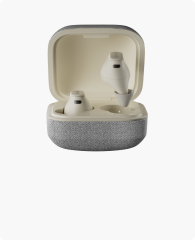It happens. Sometimes you might feel a strange pressure in your ears or uneasy in certain places, even though everything seems quiet. This is the time you might have been exposed to infrasound. These are the sound waves that are below the range of human hearing. Even though we can't always hear them, they can still affect how we feel. In this blog, let's explore what infrasound is, where it's found, and how it could impact your health, especially if you use hearing aids.
🚀 Navigate This Post
- ➤ Part 1: What is Infrasound?
- ➤ Part 2: Is It Possible for People to Hear Infrasound?
- ➤ Part 3: Infrasound Examples in Our Daily Life
- ➤ Part 4: What are Effects of Infrasound on the Human Body?
- ➤ Part 5: How to Detect Infrasound with Infrasound Detector?
- ➤ Part 6: How to Block Infrasound?
- ➤ Frequently Asked Questions
You may also be interested in:
- Dog Not Responding to Your Voice? Here's What You Need to Know About Dog Hearing Aids!
- Low Frequency Tinnitus - Ears' Deep Humming Driving You Crazy
- Can You Hear Colors? The Fascinating World of Chromesthesia Uncovered!
Part 1: What is Infrasound?
Infrasound is sound waves below 20 Hz frequency, which are sounds that the human ear can not typically detect. Infrasound can travel long distances and even pass through solid objects. While we can not consciously hear them, infrasound can create physical sensations like pressure in the ears, dizziness, or even anxiety.

Infrasound can come from natural sources like earthquakes and thunderstorms, or artificial sources like infrasound generators, engines, and even HVAC systems. Want to understand how quiet or intense infrasound can be compared to other sounds? See this helpful decibel chart for common sound levels.
Part 2: Is It Possible for People to Hear Infrasound?
Infrasound falls below the normal human hearing threshold of 20 Hz, which the human ear can't pick up. However, some individuals can still sense or feel it. The low-frequency vibrations might affect people physically and emotionally, triggering symptoms such as discomfort, dizziness, headaches, anxiety, and even nausea.

In certain cases, infrasound may be mistaken for low-frequency tinnitus, a condition in which people hear a persistent hum or buzz. For hearing aid users, these low-frequency sounds might interfere with hearing clarity and amplify discomfort. This is because hearing aids that amplify all frequencies might inadvertently increase low-frequency noise.
Part 3: Infrasound Examples in Our Daily Life
Infrasound occurs in both natural and man-made environments. Even though we can't always hear it, our bodies and especially animals can often sense it. Here are some common examples.
1. Infrasound in Nature
Since these low-frequency waves travel farther and through physical obstacles, many animals use infrasound for long-distance communication and navigation.
- Elephants emit deep rumbles to coordinate movements across several miles.
- Whales, like blue and fin whales, send infrasonic calls across entire ocean basins.
- Giraffes and some reptiles use low-frequency sounds to alert others or establish territory.
Other natural sources of infrasound include:
- Earthquakes
- Volcanic eruptions
- Ocean waves
- Tornadoes and extreme weather
These powerful phenomena generate large-scale pressure shifts that release low-frequency sound waves, often below the range of human hearing but detectable by certain animals.
Some researchers believe this sensitivity allows animals to react to danger before humans can. For instance, before the 2004 Indian Ocean tsunami, observers reported that many animals, including elephants and birds, retreated to higher ground hours before the disaster struck, which is possibly in response to infrasound produced by the underwater quake.

2. Human-Made Sources of Infrasound
Today, infrasound can also be the byproduct of modern technology. These low frequencies may cause discomfort when continuously produced. Common man-made sources include:
- Wind turbines (especially in large wind farms)
- Engines, compressors, and HVAC systems
- Airplanes, helicopters, and subways
- High-traffic roads or industrial zones
- Large buildings with certain acoustic properties
Prolonged exposure to infrasound may lead to various symptoms, for instance, fatigue, poor sleep, or irritability. Currently, the World Health Organization (WHO) has called for more research into how environmental noise, including infrasound, can affect long-term health.
Part 4: What are Effects of Infrasound on the Human Body?
While infrasound lies below the threshold of conscious hearing, it can still have a noticeable impact on the human body, especially people with sensitive hearing or those who wear hearing aids.
1. Infrasound Affects Your Ears and Balance
The inner ear contains both the auditory system (responsible for hearing) and the vestibular system (responsible for balance). Infrasound may influence these systems as follows:
- It can cause subtle fluid shifts within the inner ear, leading to sensations of ear pressure, fullness, or imbalance.
- It may stimulate the vestibular system, resulting in dizziness, nausea, or a floating sensation, similar to motion sickness.
- It can even interact with pressure-sensitive areas of the ear, potentially triggering vertigo, discomfort, or a vague sense of unease.
People with tinnitus, hearing sensitivity, or balance disorders may be particularly vulnerable to these effects.

2. Infrasound Influences Your Emotional and Cognitive Functions
Infrasound doesn't just affect your ears; it may also impact your mood and mental state. Though often below conscious perception, certain infrasound frequencies have been linked to:
- Feelings of anxiety or dread
- Restlessness or difficulty sleeping
- Concentration problems
- A general sense of being "on edge"
3. Why Hearing Aid Users May Be More Sensitive to Infrasound
It is worth noting that infrasound presents unique challenges for hearing aid users. This is because most hearing aids are designed to amplify a wide range of frequencies, which might inadvertently magnify infrasound exposure. Here are the scenarios hearing aid users might encounter.
- A distorted or overwhelming listening experience, particularly in environments with background low-frequency noise (e.g., airplanes, large buildings, HVAC systems).
- Increased perception of ear pressure, humming, or low-frequency rumbling that may not be audible to others.
- Auditory fatigue, irritability, or a reduced ability to focus in noisy environments.

Diamond X1 - Best Hearing Aids with Bluetooth
Newcomer Price
$249.99 $309.99
- ✔ Adaptive sound modes for clear hearing.
- ✔ Bluetooth for calls & streaming.
- ✔ App-controlled, customizable adjustments.
- ✔ Rechargeable & fast charging.
- ✔ Ideal for mild to moderate hearing loss.
Part 5: How to Detect Infrasound with Infrasound Detector?
As introduced earlier, the infrasound frequency is below 20HZ and can not be detected by human ears. But that does not mean there's nothing you can do. You can still use specialized tools to measure very subtle air pressure changes and vibrations caused by infrasound.
1. Common Tools for Infrasound Detection
- Infrasound microphones: Capture ultra-low-frequency sound waves and vibrations.
- Seismometers: Often used to detect infrasound from geological events like earthquakes or volcanic activity.
- Barometers and pressure sensors: Helpful for tracking weather-related infrasound caused by storms, tornadoes, or atmospheric shifts.
These tools are widely used in scientific and environmental research, such as monitoring natural disasters, studying animal behavior, detecting nuclear tests or explosions, and conducting atmospheric and climate studies.

2. Infrasound Detection in Daily Life
Aside from scientific-grade equipment, there are some methods to identify infrasound in homes or workplaces.
- Loud HVAC systems or industrial machinery
- Nearby traffic, subway lines, or aircraft noise
- Unexplained discomfort or "pressure" sensations in certain environments
Part 6: How to Block Infrasound?
It can be challenging to block infrasound completely because these sound waves travel long distances, penetrate walls, and pass through solid materials. However, there are several ways to reduce exposure and minimize its effects.
-
Soundproof Key Areas
The first thing you can do is to prevent infrasound from entering your space. These materials can absorb or dampen some low-frequency energy.
- Install mass-loaded vinyl (MLV) in walls and floors to block low-frequency vibrations.
- Add dense insulation materials such as acoustic foam or fiberglass.
- Use double-pane or acoustic windows to reduce external rumble.
- Seal gaps around doors and windows with weatherstripping or acoustic seals.

Isolate Vibration Sources
Many infrasound sources are mechanical and can be controlled. You can try to reduce mechanical vibration at the source to help lower infrasound output.
- Place anti-vibration pads under heavy appliances like washers, fans, or generators.
- Use rubber mounts or shock absorbers for HVAC systems and machinery.
- Turn off or relocate problematic devices when possible.
Rearrange Furniture and Decor
Surfaces like bare walls and floors can amplify low-frequency sound. You can try these adjustments to reduce the buildup of infrasound indoors.
- Add rugs, curtains, or bookshelves to break up sound reflections.
- Rearrange large furniture to disrupt echo pathways.
- Use wall panels or tapestries to soften the room's acoustics.








Leave a comment
All comments are moderated before being published.
This site is protected by hCaptcha and the hCaptcha Privacy Policy and Terms of Service apply.